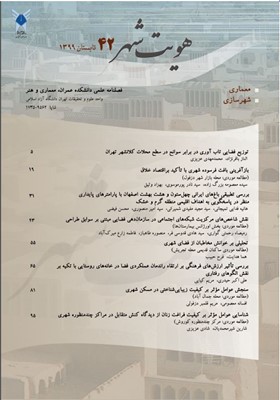تحلیلی بر خوانش مخاطبان از فضای شهری (مطالعه موردی: ساکنان قدیمی محله تجریش)
محورهای موضوعی : معماری
1 - دکترا شهرسازی دانشکده هنر و معماری، دانشگاه آزاد واحد علوم تحقیقات، تهران.
،ایران.
2 - استاد دانشکده عمران، هنر و معماری، واحد علوم تحقیقات، دانشگاه آزاد اسلامی، تهران.ایران.
کلید واژه: رویکرد مخاطب محور, فضای شهری, تئوری زمینهای, تئوری تعادل,
چکیده مقاله :
فضای شهری را میتوان متنی حامل معانی تصور کرد که خوانندگان، کاربران آن هستند. از میان نظرات مطرح در برخورد با مقوله معنا در متن، علم هرمنوتیک و خصوصاً رویکرد مخاطب محور در این مقاله مورداستفاده قرارگرفته است. هدف از این مقاله خوانشی بر میدان تجریش از دیدگاه یک گروه از مخاطبان آن (ساکنان قدیمی محله تجریش) است. در پی این خوانش معیارهایی برای ایجاد فضای شهری مطلوب متکی بر شناخت مخاطبان به دست می آید. روش تحقیق این پژوهش، روش کیفی با استفاده از تئوری زمینهای است. در این روش با استفاده از اطلاعات بهدستآمده از مصاحبه عمیق و رمزگشایی آنها، به تحلیل این اطلاعات میپردازد که درنتیجه به دو شریان اصلی هویتی و زندگی دست می یابیم و در جمعبندی با روش تئوری تعادل نکات مثبت و منفی شناسایی و با دستهبندی آنها به معرفی دقیق مشکلات و ارائه راهکارهای پیشنهادی میرسد.
Major components of space are form, meaning, and function. If these factors have a similarity to the space environment, space will be more successful and efficient. In other words, physical urban space can be imagined as a text which contains meanings. Readers who read the text can be imagined as the people living there. All of the above mentioned are Hermeneutics science. One of the most important theories of this approach is related to Georg Gadamer that the present study has been based on it. In his opinion, the aim of Hermeneutics is the combination of horizons, which means the combination of the interpretative horizon and the text horizon. In urban space, the users of space have a deeper and more accurate understanding of the space that the understanding is very difficult for urban designers to access this information. Urban designers need this information to gain a scientific method that provides the correct information. The purpose of this paper is the use of old citizens' recognition to identify the problems in the urban environment to improve it. It has been tried to use this approach in practical use. In this study, "Tajrish square" has been used as a case study. The method used in this study is the qualitative research method. This means that a researcher interprets phenomena in their natural context and analyses the cognition and interpretation of phenomena in people’s views. In this method, the analysis of deep interviews to identify the main issues and its editing has been done in a consistent format. One of the qualitative approaches is grounded theory that includes information gathering, coding (open, axial, selective), and the basis of theory. Tajrish was chosen as the case study because of having a variety of potentials like leisure, tourism, history, religion, and economy. Firstly, ten residents and elders of the Tajrish area were selected as the statistical population for the interview. Similar techniques or flip-flap, different techniques or far out and challenge technique or red flag have been considered to form questions. These three techniques help to find an accurate cognition of Tajrish square. Background, phenomenon, causal factors, action and reaction, intervention factors, and results have been considered to form the questions in grounded theory. After gathering interviews, the analysis of data has been done through coding. Interviews have been done in an accurate way, and after identification of main codes by open coding, the codes arranged by axial coding. After that two major axes are selected by particular coding. These axes include the "life artery" and "identification artery" of Tajrish square. The Life artery includes four main axes (economical, social, functional, and legal context). The Identification artery involves historical, natural, religious, cultural context. after that use context analyses and get the importance of each of them. Furthermore, theBalance theory has been used to collect codes. The main purpose of this research has been divided into two positive and negative groups. In the next step, the kind of relationship and the identification of compatible and incompatible factors lead to presenting guidelines.
آذر، عادل. (١٣٨٠), بسط و توسعه روش آنتروپی شانون برای پردازش دادهها در تحلیل محتوا. فصلنامه علوم انسانی دانشگاه الزهرا، 11 (37 و 38), 1-18.
پالمر، ریچارد. (1377(. علم هرمنوتیک. (محمد سعید کاشانی، مترجم). تهران: انتشارات هرمس.
سلطانی، علی. (1389(. بررسی تأثیر نیروهای مختلف در شکلگیری فضای شهری. نشریه هویت شهر،5 (7)،123-130.
سعیدی رضوانی، نوید (خستو، مریم). (1389(. عوامل مؤثر بر سرزندگی فضاهای شهری، نشریه هویت شهر، 4(6)،63-74.
کالن، گوردون.(1377). گزیده منظر شهری، (منوچهر طبیبیان، مترجم). تهران: انتشارات دانشگاه تهران.
کریر، راب. (1375). فضای شهری. (خسروهاشمی نژاد،مترجم). تهران: انتشارات جهاد دانشگاهی.
منصوریان، یزدان. (1386). گراندد تئوری چیست و چه کاربردی دارد. همایش چالشهای علم اطلاعات،خرداد.اصفهان: دانشگاه اصفهان.
مهندسان مشاور بافت شهر. (1386). طرح تفصیلی منطقه 1 تهران: معاونت شهرسازی و معماری شهرداری تهران.
Carp,F, & Zawadski, H. (1976). Dimension of urban environmental quality. Environment and Behaviour,8, 239-264
Eyles,J. (1990). Objectifying the subjective:the measurement of environmental quality. Social Indicators Research, 22,139-153.
Klein, D. A., & Walsh, B. T. (2004). Eating disorders: clinical features and pathophysiology. Physiol Behave, 81(2): 359-74.
Shannon, C. E. (1984). A mathematical theory of communication, Bell system technical journal, 27, 106-111.
Van poll, R. (1997). The perceived Quality of the Urban Residential Environment. A Multiattribute Evaluation. Phd-thesis, center for Energy and Environment Studies(IVEM), University of Groningen(RuG), The Netherlands.
Van poll,,R., & Hendrichx, L,(1993). Sources of Annoyance in the urban Residential Area. Archives of Complex Environmental Studies, 5, 27-35.
_||_

